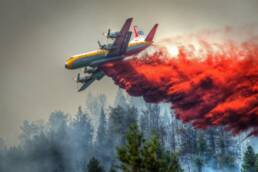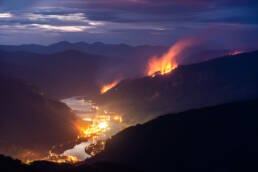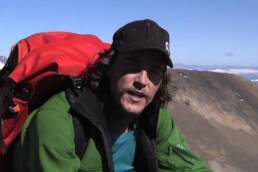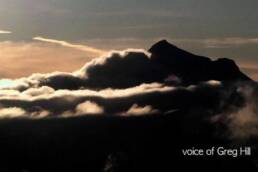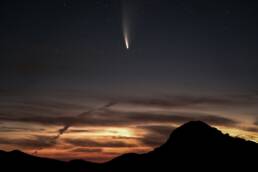From prescribed burns to predicting future flames, forest-fire ecologist Robert Gray knows more than most. So why is his expertise going unheeded? After a record-breaking summer of smoke, veteran CBC journalist Jeff Davies investigates Gray’s know-how, and the naysayers.
It’s a grey and blustery October day at the Kimberley Nature Park in southeastern British Columbia. The trees are bending and creaking in the wind, bringing down showers of needles from the larch, fir and pine trees. The skies are mottled and brooding, but there are still splashes of gold in the autumn forest. Severe weather is on the way, with wind and rain in the valleys and snow in the mountain passes.
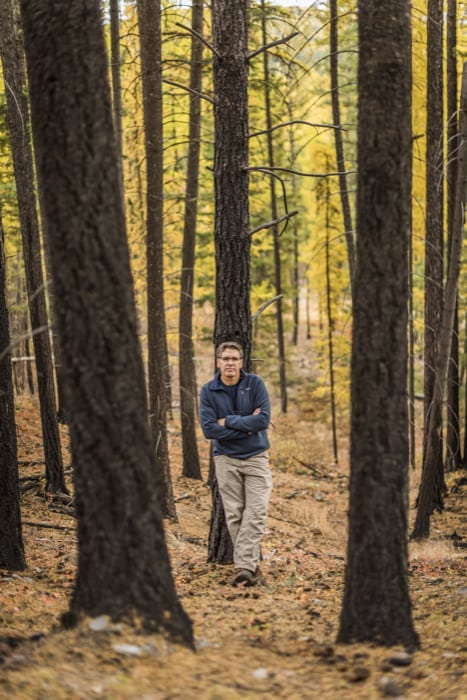
On days like this, it’s easy to believe change, perhaps harsh and unrelenting change, is in the air: change in the climate, in the forests, and in the way we look at and manage those forests. And that’s exactly why Bob Gray has brought me here for a walk and talk.
“We burned this last year,” Gray says, as we head up the hill. Yet the prescribed burn did not leave behind a blackened landscape. “It shouldn’t. We want to consume the fine fuels, the litter, but we want to keep the trees alive because if we kill a bunch of trees we just create a future fuel problem.”
The Chilliwack, British Columbia-based professional heads his own company, R.W. Gray Consulting Ltd. He has devoted much of his life to understanding and working with wildfire. He’s now described as a fire ecologist, advising governments and communities on both sides of the Canada-US border. But he’s also a hands-on guy; he’s worked on firefighting crews and with First Nations, served as a forest technologist and been a “burn boss” in the field.
As he speaks, we’re nearing the end of the worst wildfire season on record in BC. While the number of fires was below the 10-year average, the profile was strikingly different. There were more big fires, some huge, one the biggest on record, and the total area burned was eight times the average. It cost the BC government a whopping $525 million just to fight the fires, to say nothing of the cost of providing emergency services, the cost of lost homes and buildings, or the loss of timber, jobs and revenues in the forest industry. All told, the fires consumed 1.2 million hectares (3 million acres) of forest.
That is twice the size of Prince Edward Island, Canada’s smallest province, which is 566,000 hectares (1.4 million acres), and more than one-third of the size of Vancouver Island, which measures 3.13 million hectares (7.7 million acres). One fire alone, in the sprawling and sun-baked Chilcotin plateau, covered more than half a million hectares (1.2 million acres). That’s more than enough to devour the seven smallest countries in Europe, from Vatican City to Luxembourg, combined, plus Greater London.
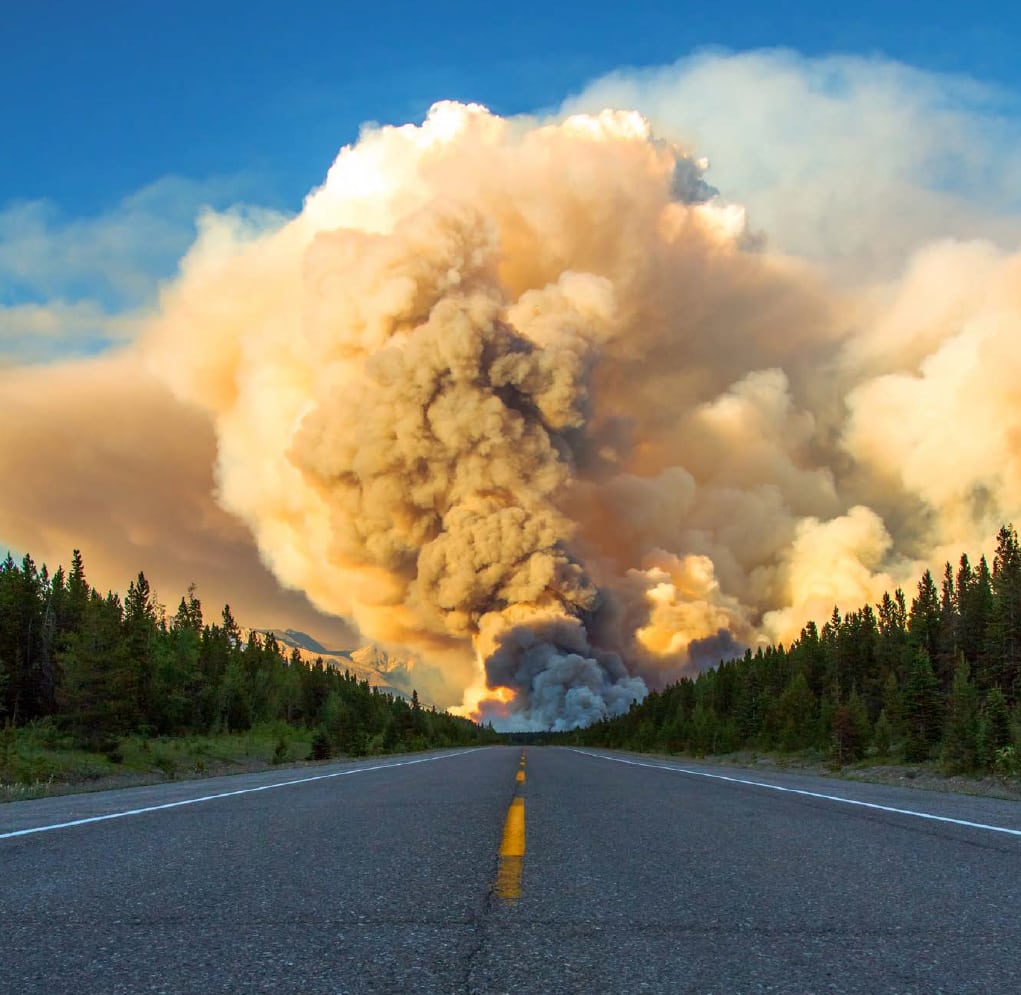
It must be tempting for Gray to say, “I told you so,” to remind politicians of all the warnings he and others have issued over the years about the dangers of huge wildfires. But, he asks, what would be gained from that? Gray wants to look ahead: “Unfortunately we are not going to solve this overnight. This is going to take decades. We are looking at a generation that is going to have to get used to some smoke and maybe after that things will lighten up a little bit.”
Gray could repeat all his warnings from the past 15 years about the need to thin the forests around BC communities; to have prescribed burns; to get rid of the piles of slash, the dead wood and needles on the forest floor; to find new ways to use the wood through pellets and bioenergy; to see the forest as something other than a tree plantation supplying fibre to industry; and to encourage rural property owners to fireproof their homes.
He could talk about how fire can be a natural part of the forest ecosystem and a source of renewal and regeneration. He could say, yet again, how we need to act now, to prevent so-called “megafires,” fires of such heat and ferocity that they burn into the soil and create their own weather systems, sending out forks of dry lightning and emitting clouds of acrid smoke and swirling embers, consuming houses and farms, threatening lives and livelihoods, leaving little but a scorched landscape behind. And he could speak, again, about how climate change forms a backdrop to all this.
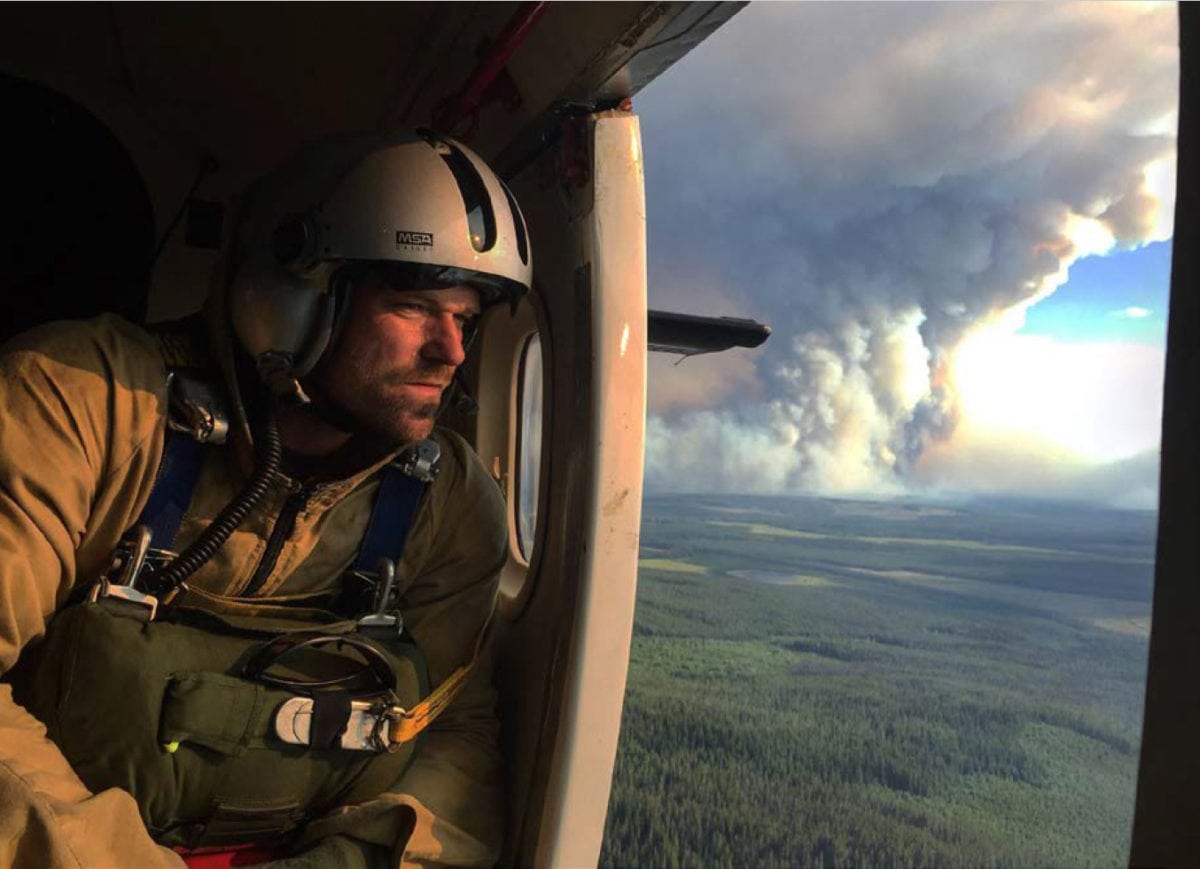
Or Gray could simply cite the report Firestorm 2003, which he co-authored. The BC government appointed former Manitoba Premier Gary Filmon to head a commission of inquiry after the so-called “summer of fire,” the summer in which residents of Barriere and Kelowna watched helplessly as their homes burned to the ground. The commission’s February 2004 report painted a picture of drought and parched forest, of dry soils and record low river levels. It warned of bigger fires in the future—and a growing threat to communities: “The wildfire zone is not only getting closer to people, but people are getting closer to the wildfire zone.”
Gray and I are in such an area today, but one where the community is taking steps to prevent wildfires. Gray has helped to supervise efforts at the Kimberley Nature Park to reduce the threat of wildfire through mechanical and manual harvesting, thinning and prescribed burns. The fact we’re in a park is itself telling. In the past Gray encountered stiff opposition from environmental activists to the thinning, cutting and burning he felt was necessary to prevent wildfires from spreading from parks to nearby communities. He recalls a meeting in 2003 where one well-known activist “pounded the table and stated that there would be no logging roads in ‘his’ parks. I waited until he was done and then pointed out you proactively treat these areas, or, once the wildfire breaks out, you get emergency cat guard, feller bunchers and skidders, and lose all control of where they go and what they do.”
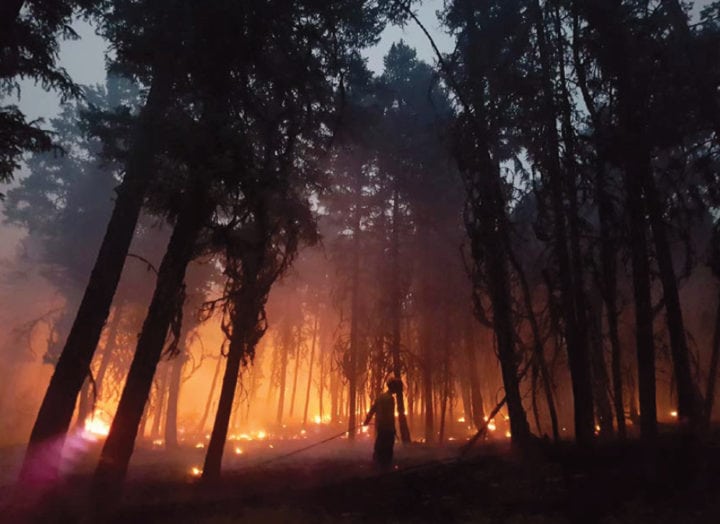
It is not the vision of “Super, Natural British Columbia” touted in glossy tourist advertising. But then, as Gray points out, much of what one sees in valley bottoms here in the East Kootenay isn’t “natural” at all. A century ago much of this was savannah, with meadows, bush and a few large trees, particularly larch, which is more resistant to wildfire. First Nations, he says, “grasped the fact that fire was an essential part of the ecosystem. They could not survive without it. They had a very sophisticated knowledge of fire effects.” They burned off trees as required to encourage the growth of root crops, bulbs and berries to attract wildlife and feed their families. But for much of the past century, the view was that wildfire was a threat to be prevented, fought and doused as quickly as possible. Remember Smokey Bear? “You look at historic density, you had a tree here, two trees down there and two trees over there … about 12 trees per hectare [2.5 acres] historically,” Gray says, pointing down the hill. Now there are about seven thousand trees and many of them are lodgepole pine, which is susceptible to beetle kill and, of course, larger fires that are more difficult to control.
You don’t have to tell the people of the Cariboo just how difficult it has become to control wildfires today. The images of last summer’s devastation in central BC are stark: the Elephant Hill fire near Ashcroft burned through a trailer park and a First Nations reserve. Other fires swept through the Cariboo ranch lands and resort country. Hundreds lost homes, cabins and outbuildings. Former Minister of Forests John Rustad toured the area in July and posted photos on Facebook that look nothing short of apocalyptic: communities burned to the ground, with nothing left but chimneys, rubble, a few pieces of metal and a scorched hydro pole. Rustad told a reporter he didn’t think the biggest fires could have been prevented: “obviously hindsight is 20/20.” His successor, Doug Donaldson, says the NDP government has commissioned its own independent review, but, not surprisingly, he adds, “not enough by was done by the previous government on fuel load.”
In the past Gray encountered stiff opposition from environmental activists to the thinning, cutting and burning he felt was necessary to prevent wildfires from spreading from parks to nearby communities. He recalls one well-known activist who “pounded the table and stated that there would be no logging roads in ‘his’ parks.”
Even when communities were spared the worst, the emotional toll was high. Mike Handley of Wild Eyes Photography lives in Sunshine Bay on the west arm of Kootenay Lake, near Nelson, British Columbia. A fire sparked by lightning in late July 2017 burned in mountainous terrain behind his home for the rest of the summer. Then in mid-August, another strike triggered a fire much closer to homes on the other side of the lake. “I’m tired,” Handley posted on Facebook. “I’m tired of the smell of burning forests. I’m tired of hearing helicopters and planes and knowing that hundreds of people are risking their lives to save our homes. I’m tired of having my most important and valued possessions packed and ready to go on a moment’s notice. I’m tired of the heat and the relentless sun. I’m tired of the smoke, the headache, sore throat and burning eyes. I’m tired of being scared, of seeing my loved ones scared….People are strained, patience is wearing thin and it’s starting to show.”
It was also a devastating year in many areas of the American Northwest, with major fires in Montana and Washington state, and thick clouds of smoke blowing back and forth across the international border. And now, in October, as Bob Gray speaks with me, fires are raging through wine country in California, leaving dozens dead and many more missing. The fires spread so quickly many had to drop everything and flee.
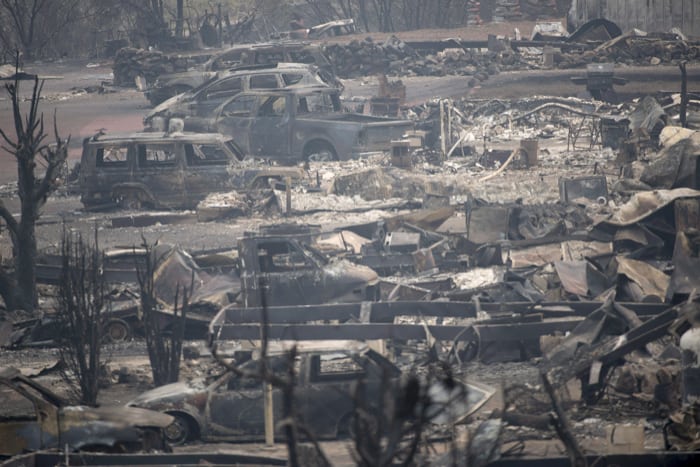
Gray, meanwhile, wants to rethink the way we manage our forests and chart a course out of the firestorms. It won’t be easy. It means new forest policies and a new mindset, for government and for industry, for recreation and for homeowners—what social scientists would call transformational change. “We have to live with smoke and…we have to live with fire,” he says again. There are no “no smoke” options, a line he used many times in the media during the wildfire season. We will either have prescribed burns and smaller fires now, or we will eventually have catastrophic fires and the recovery will be much more difficult. “There are a lot of very tough political decisions to be made. But we either make those decisions or Mother Nature makes them for us.”
Filmon’s report introduced British Columbians to terms such as “the wildland urban interface,” where the forest meets the town and the threat of wildfire is greatest. It warned of the growing “fuel load” of needles and branches and dead wood on the forest floor. It spoke of “ladder fuels” and “crown fires” that would spread quickly and dangerously. It warned of the consequences of not allowing some fires to burn: “When wildfires are successfully suppressed, the fuel that would normally burn during those fires tends to build, sometimes resulting in uncontrollable fires like those witnessed in Firestorm 2003.” Above all, the Filmon report spoke of the need for governments to act quickly to reduce the threat. The BC government accepted the recommendations and promised to act.
Looking back today, Gray says he hoped that many communities could be deemed fire safe by now. Instead, “the problem is as big or bigger than it was then, because, of course, the conditions continue to deteriorate. We treat some areas and have to go back and do maintenance on them. The areas that we thought were low to moderate hazard are probably high hazard now because, of course, that was all before the mountain pine beetle epidemic,” he says. Then there’s the impact of climate change, “which is going to put more and more pressure on trees. They’re fighting for light and moisture and nutrients. This is just going to stress them out. We’re going to have mortality. And then we have forest fires and we go back and replant them in the high-density stands again. We are awash in fuel in BC.”
Gray, meanwhile, wants to rethink the way we manage our forests and chart a course out of the firestorms. It won’t be easy. It means new forest policies and a new mindset, for government and for industry, for recreation and for homeowners—what social scientists would call transformational change.
Back in 2004, the BC government estimated the size of the “urban interface” where the fuel load must be reduced at 1.7 million hectares (4.2 million acres). In 2010, it refined the figure, estimating the size of the “high-risk” area at 680,000 hectares (1.7 million acres). At the time, Gray said he was concerned the government was underestimating the risk and failing to get the job done. Then in 2015, the BC Ministry of Forests, Lands and Natural Resource Operations updated its threat analysis and concluded 1.35 million hectares (3.3 million acres) were in high-risk areas, and so far only 100,000 hectares (247,000 acres), about eight per cent of that land base, has been treated for fuel reduction.
Ominously, a map of the province illustrating the wildfire threat shows splashes of red west of Williams Lake and Kamloops, precisely the areas where the biggest fires burned last summer. The ministry of forests says there’s been an increase in high-risk zones partly because of the construction of subdivisions in previously forested areas. That is exactly the trend that Gray has been warning about: “There are places like the Okanagan where it’s a lot of private land, it’s in really bad places, steep, warm aspects, lots of fuel on it, and they just keep developing it. You know, local politics are driven by real estate and land development so those are real problems.”
Gray praises the communities of Kimberley and Cranbrook, which are taking steps to reduce the threat. But overall, “we [fire ecologists] are very, very frustrated.… Thirteen years later you can’t look at a single community in BC and say it’s fire safe.” The province does have some fire prevention and fuel reduction programs, most notably the Strategic Wildfire Prevention Initiative (SWPI), overseen by the Union of BC Municipalities, which offers grants to reduce wildfire risk, “within 2 kilometres of a community and with a minimum density of 6 structures per square kilometre.”
It must be tempting for Bob Gray to say, “I told you so,” to remind politicians of all the warnings he has issued over the years about the dangers of huge wildfires. But, he asks, what would be gained from that?
Gray says much more work is necessary and it really should be the BC government, not municipalities, taking the lead. And he thinks the unforested buffer around communities may have to be larger, as much as 10 kilometres. He faults the former Liberal government for easing the requirements to remove logging slash from the forest floor: “We hit a recession and things were tough in the timber industry and they were allowed to leave more slash, so we didn’t do a good job in that 13-, 14-year period in cleaning up the forest.”
At the national level, a wildland fire strategy commissioned by the Canadian Council of Forest Ministers admits, “progress has been slower and more costly than anticipated.”
Edmonton writer Ed Struzik’s new book, Firestorm: How Wildfire Will Shape Our Future traces the history of fire suppression from the early days of European settlement in North America right up to the fire that devastated much of Fort McMurray, Alberta, in 2016. He shows just how difficult it is to change course: “The development of this new relationship with wildfire in the northern forests was fraught with trial and error and pushback from politicians, the public, and plant and animal ecologists who continued to see fire as a destroyer and not a birther.” As Struzik notes, following huge fires at Yellowstone National Park in the US in 1988, President Ronald Reagan “dismissed the ‘let burn’ policy as ‘cockamamie.’”
Times are changing and attitudes are evolving. But have we gone far enough fast enough? Brian Simpson, who retired as executive director of the BC Wildfire Management Branch in January 2017 after 37 years in the field, doesn’t think so: “It’s not about what’s going to happen next year because quite frankly the table is set. We’re going to take our lumps and our successes as they come, but it’s about what we need to do to deal with what is coming in 2050 or 2040. If you listen to the experts, they are telling us that the fire intensity is going to be double what it is today. So imagine 2017 on steroids.”
Simpson says manual harvesting and thinning and prescribed burns around places like Kimberley can help. But, “if you have a 10,000-hectare [25,000-acre] fire bearing down on a community, it isn’t going to matter how much fuel treatment you’ve done in and around that community, if it has that kind of head of steam it will blow through that community anyway…We need to move away from, as my crews used to call it, the ‘pick up sticks’ kind of techniques because it’s too laborious and it takes too long to do the kind of work we need to do as quickly as we need to do it.”
Simpson says government and industry must work together to plan strategies for the future, with wildfire management front and central in land-use decisions, whether it’s forestry, tourism, highway construction, energy, pipeline building or anything else that can have an impact on the landscape. That could mean building fire breaks now through mechanical harvesting, rather than waiting for the wildfires to start, and routing or expanding highways so they too serve as fire breaks. It would be better, Simpson says, to spend more money up front than on the back end, after the fires break out. But that’s not the political reality today. “Once there is a fire we can spend until the cows come home. No government has the balls to say, ‘no, we’re going to turn off the tap. It’s costing too much.’”
Simpson would also like to see more onus on property owners to protect their own structures by securing flammable materials and installing sprinkler systems before they get an occupancy permit. He tells of visiting a luxury backcountry lodge in mountainous terrain near Invermere, British Columbia, during a wildfire in 2012. It was a beautiful building for well-heeled hikers and skiers, with a pond in front, lawns kept green by in-ground sprinklers, and 15 cords of dry firewood stored under the sun deck. Meanwhile, fire crews were beating back a fire on a ridge above the lodge to protect the property.
Simpson asked the lodge owner if he had installed structural sprinklers on the building. He just got a funny look in return; there were no sprinklers. He also told the owner to move the firewood and got a commitment. But when he returned two weeks later, “Not a damn thing. Never moved a stick. And meanwhile the taxpayers were spending half a million, probably more, that we wouldn’t have spent. Where is the sense in that?” It’s a fair question, and one that will be asked more and more as the reality of last year’s fire season sinks in for British Columbians.
If Brian Simpson, the retired firefighting boss, sounds hard-nosed and practical, Bob Gray, the wildfire ecologist, remains reflective and almost optimistic.“It shouldn’t be desolation,” notes Gray, as we scramble around the Kimberley Nature Park. “If the prescribed burn is done right, you should be able to meet your objectives.”
Today, there’s fresh growth in the park, with grasses and shrubs sprouting among the remaining trees, some of those shrubs come from seeds that lay dormant in the soil for years or decades before being released by the warmth. There are hikers and dog walkers here, as well as kids on a school field trip. Gray speaks often of the First Nations, how they realized the value of fire and used it as a tool.
So while these two forest professionals may differ in their vision, their background, their experience and their approach, they agree on the hard facts about living in a province defined by its forests. As British Columbians ponder last year’s wildfires and look ahead to the future, there is one thing they can count on: there will be smoke.
Jeff Davies
Jeff Davies is a freelance writer and retired CBC political report based in Victoria, British Columbia. He left the legislative press gallery in 2012 to spend more time enjoying the great outdoors and writing about it.
Related Stories
Forest-Fire Ecologist Robert Gray: “It’s Going To Get Worse.”
Last year we interviewed British Columbia forest-fire ecologist Robert Gray for a story in CMC magazine. This year,…
Greg Hill And His Quest for 2MiL
Check out this video of Revelstoke mega ascender, Greg Hill on his quest to shag 2 million vertical feet in one year.…
Greg Hill On His Way to 2 Million
Revelstoke, BC guide and backcountry goat, Greg Hill, recently topped two million vertical feet in one year. Which is…
Vanderham and his Top Five Shred Spots
The boys over at Toyota BC got their rider--B.C.'s born and bred Thomas Vanderham--to throw down his top five spots to…
Great Balls Of Fire: A Look At Famous BC Meteorites
Unsure if that blazing night light was a UFO? Maybe it was one of these extraordinary meteors that has entered British…
How First Nations Managed Forest Fires in BC
En route to her PH.D., a formidable researcher has made surprising discoveries about how first nations managed forest…


